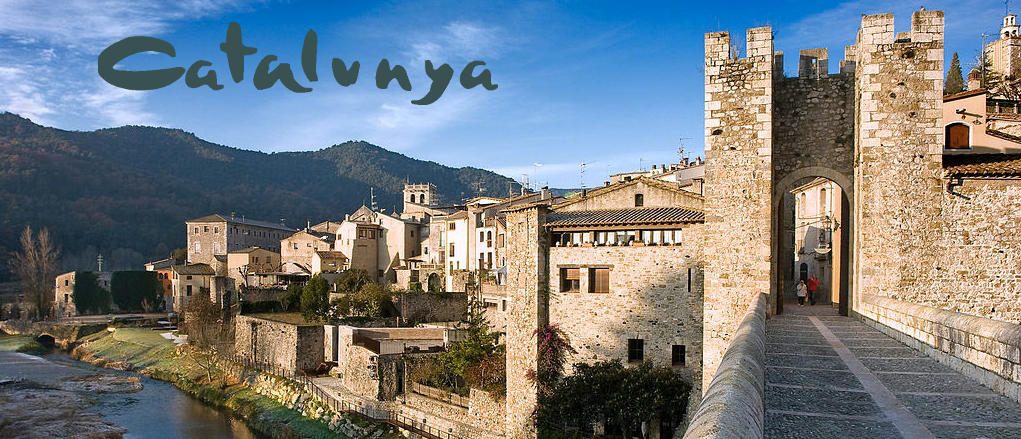We are leaving the Costa Brava for a week to walk inland to Girona and back to the coast.
Via Verde: Sant Feliu de Guíxols to Girona via Llagostera
A small steam train known as the “Feliuet” made trip between Sant Feliu de Guíxols and Girona from 1892 till 1969. Now its route is a Via Verde (Rail Trail). We followed it.
- Sant Feliu de Guíxols to Llagostera 18km, 4¼ hours gradually climbing 150 meters.100th
- Next day, Llagostera to Girona 22km, 5 hours descending slightly.

Via Verde (Rail Trail) from Sant Feliu de Guíxols to Girona

The first stop was Castell d’Aro Station, with a “Feliuet” train and its controls

Santa Maria de Castell d’Aro consecrated in 1018

Font-Picant Station – the Via Verde is popular with bike riders

Someone has painted the hay bales for a flower festival

Nice walking in the shade through cork forests – the cork industry flourished with the train line

Church of Sant Feliu (Llagostera) – Gothic, 15-17th centuries

Cassà de la Selva once was served by the train

Corks are produced here in Cassà de la Selva

The Rail Trail goes on to Girona
Girona
We took a day off in the historic city of Girona – the legacy of Iberians, Visigoths, Romans, Moors, Jews and Catalans.

Brightly colored houses overlooking the Onyar River which flows through Girona

A couple walks up the 90 steps to the Cathedral (14th-18th centuries)

Basilica of Sant Feliu with slender Gothic bell tower (14th-16th centuries)

“Qui besa el cul de la lleona retorna a Girona” – “Who kisses the bum of the lioness will return to Girona”
Lion climbing Romanesque column + early Christian sarcophagi on the walls of Basilica of Sant Feliu

The 12-15th century Jewish Quarter is a labyrinth of narrow medieval streets

Romanesque Monastery of Sant Pere de Galligants and Chapel of Sant Nicolau

9th century city walls

View from the city wall

Romanesque (12th century) Arab Baths – entrance and changing room

Saturday market in the park
Cassà de la Selva
Walking into Girona we spotted a sign advertising the annual Fira de Santa Tecla at Cassà de la Selva. The tourist office in Girona rang the Cassà Ayuntamiento: “There’s nothing on except giants on Sunday”. GIANTS! We had to go.

A unique couple of Egyptian Pharaohs made in 1959

Preparing the Queen while the King looks on

A country couple are ready

Giants coming

The “Big Heads” got a great reception

Skirts twirling; King and Queen dancing

Giants come in pairs
Els Angels to Peratallada
We took the bus from Cassà back to Girona so it was 1:30 by the time we started uphill on the Camí dels Àngles (Path to the Angels) and it was hot, 35C. The path’s about 9km long and 400 meters up – 2 hours.
El santuari dels Àngels (1409) is a wonderful place to stay with cool mountain air and views of the Medes Islands and the Pyrenees from our room.

Some shade is welcome when it’s 35C!

The Sanctuary of the Angels dates from 1409, but there has been many modifications
Next day, 22km mostly downhill, 5 hours to Peratalada . After a descent through forest we arrived at the tiny pueblo of Sant Sadurní de l’Heura and from then on there were delightful villages each with a Romanesque church every few kilometers, a pleasant surprise which made the walking easier.

Sant Sadurní de l’Heura

Sant Miquel de Cruïlles, 11th century Benedictine Monastery

La Bisbal d’Empordà Palace Castle – 11th century Romanesque civil building

We ended up off track and came across the 9th century Pre-Romanesque Sant Esteve de Canapost with its unfinished bell tower
Peratallada is an intact medieval village that has not expanded beyond the original walls. The houses were mostly constructed from stone cut to make the town’s moat. There’s still ruts in the stone paths from years of the passage of carts.

Sant Esteve de Peratallada is a Romanesque church protected as a cultural asset

Streets of Peratallada
Peratallada to Pals
It’s only about 7km to Pals from Peratellada, with a slight diversion to Sant Feliu de Boada to admire the 16th century Gothic church. Pals has an attractive historic Gothic Quarter on a hill surrounded by plains where rice has been grown since the 15th century.

Church of Sant Feliu de Boada was rebuilt in the 16th century

Pals – cobbled streets interrupted by semicircular arches

Església de Sant Pere (Saint Peter) was rebuilt with stone from the castle in 1478

What a lunch! Pals rice casserole – delivered slightly underdone so continues to cook as you eat
We had passed through Pals a week before en route to Begur, so our Girona circuit was complete and we are back to the Costa Brava.
